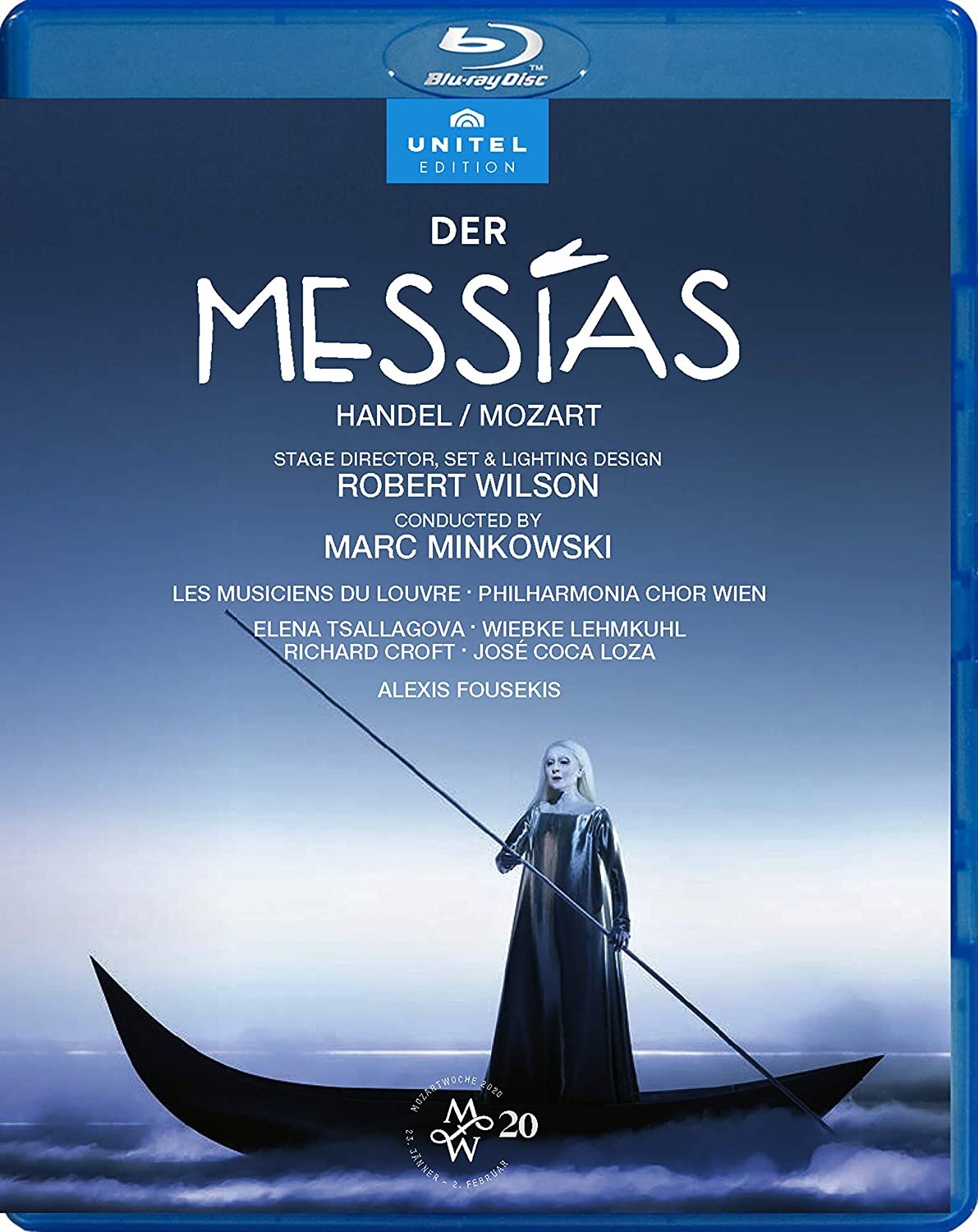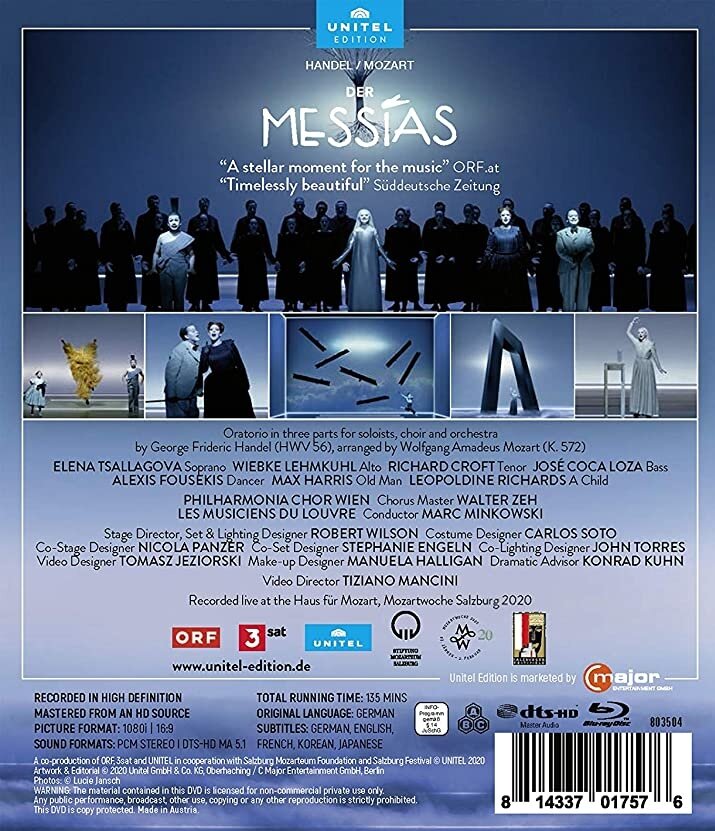

Der Messias oratorio concert. This is the Handel Messiah (1741) arranged by Mozart (K. 572 from 1789) with the Jennens English compilation of biblical texts translated into German by Christoph Daniel Ebeling and Friedrich Gottlieb Klopstock. Directed during Mozartwoche 2020 by Robert Wilson at the Haus für Mozart in Salzburg. Stars Elena Tsallagova (Soprano), Wiebke Lehmkhul (Alto), Richard Croft (Tenor), José Coca Loza (Bass), Alexis Fousekis (Dancer), Max Harris (Old Man), and Leopoldine Richards (A Child). Marc Minkowski conducts Les Musiciens du Louvre and the Philharmonia Chor Wien (Chorus Master Walter Zeh). Set and lighting design by Robert Wilson; costume design by Carlos Soto; co-stage designer was Nicola Panzer; co-set designer was Stephanie Engeln; co-lighting designer was John Torres; video design by Tomasz Jeziorski; make-up design by Manuela Halligan; dramatic advisor was Konrad Kuhn. Directed for TV by Tiziano Mancini. Sung in German. Released 2020, disc has 5.1 dts-HD Master Audio sound. Grade: A+
Introduction
The main theme of this review is an examination of the Robert Wilson “anti-Freud” concept of the unconscious mind. This review also reports on what appears to be the only modern recording available new from a trusted label of Handel’s Messiah as arranged by none other that Wolfgang Mozart (K. 572)!
First an executive summary of Wilson’s psychological approach: The human mind creates our concept of the world through astute observations about electric stimuli received from our many senses. But we also believe that there is a sub-conscious mind that has huge but never directly observed influence on our behavior. Per Sigmund Freund, the sub-conscious mind is a seething cauldron of sexual impulses often expressed consciously in “surreal” art. Wilson, to the contrary, believes the sub-conscious is a more benign construct that seeks peace, balance, and serenity, and Wilson expresses this also in surreal art.
Now a word about the music. All readers of this review probably have heard Handel’s English-language Messiah several or many times. But probably very few have ever heard Mozart’s German Language K 572. Anyone who is knowledgeable about the details of English version will probably notice numerous changes Mozart made to bring the work up-to-date with new instruments invented since Handel’s day, etc. Everyone who loves choral music should try this amazing recording! This might be the most important fine-art HDVD yet published.
The Show
Wilson is an expert in depicting the boundaries of the unconscious, which I’ll call here the soul, in his lighting. Our first 4 screenshots below illustrate this. Wilson is in love with LED strips, as you can see in our first image below with LEDs outlining the outside of the stage, the stage itself, and even (new here) embedded in the floor. It seems each strip is controlled individually by hand or computer to allow any combination of lighted strips desired. Wilson typically has a light feature on the back wall that can expand into a horizontal strip of light. The soul enjoys knowing where the horizon is. Wilson cheerfully uses soft spots for ambient light and hard spots on featured characters. He rarely creates a set and uses few traditional props. But he does like muted video for extravagant effects and often uses parts of dead trees, often in silhouette. The soul shies away from what is real and temporary but loves symbols that are eternal. Oh, yes, there’s a man on stage—dancer Alexis Fousekis, with typical Wilson baggy pants and suspenders. The soul does not like to be caught with its pants down:
What you see next below is not the moon. It might be a gigantic gas planet in another solar system, or a proton. It’s just a sphere, a universal symbol of equality, fairness, balance, repose, and peace. Oh, yes, here’s a tenor, Richard Croft, trying to express to you in his song the tranquility of the Word and of Robert Wilson’s concept of the soul:
Next below is Wilson’s wildest use of light yet: A blacked-out void except for low-powered LED strips, a feeble horizon, and one weak spot light on another of Wilson favorite characters, an old man with a beard. Maybe the soul likes to sleep too:
Finally, next below is Wilson’s brightest stage, which he creates for the famous Hallelujah Chorus. All Hell has broken loose with the destruction of the universe as observed by dancer Fousekis in his moon-suit (or maybe hazmat gear). But the soul, invincible, is oblivious to such a ruckus.
Wilson’s favorite background color is the calm, serene, gray-blue present here. (He will use another background color if the subject of the opera demands it.)
For other examples of typical Robert Wilson lighting prowess, see Adam’s Passion, Turandot, and Einstein on the Beach.
Next we turn our attention to how Wilson presents his characters. Here the soul adores fanatical neatness and adherence to a meticulous code of proper presentation. Everyone on stage is dressed in an original costume intended by Wilson to please the soul. The keepcase gives credit for the costume designs to Carlos Soto, a New York director and designer who has long worked with Wilson and would be an alter ego in all matters involving cloth. The costumes are often made from unusual fabrics like extremely rough but neat corduroy seen below on chorus members. Men’s hair is (it seems) cut short and saturated with wax to maintain a precise style. The women usually receive some version of the “Robert Wilson bob” seen below or some other style you probably haven’t seen elsewhere:
Next below is a close-up of Richard Croft in typical Wilson dress. Tailors make a loose but carefully shaped three-piece suit from rough fabric with odd features such as short lapels and out sized buttons (several shiny). A bow tie is provided which probably has a plastic body under the fabric to keep its impossibly extravagant shape. The costume is complemented with special makeup that includes huge false eyebrows, painted on eyelashes, and special lipstick, etc.:
Next below is Max Harris as the Old Man with his obviously phony beard. The soul likes the comfort and safety provided by gloves.
Most of the characters and chorus members act in slow motion to avoid exciting the soul too much. But here the Old Man and the tenor try to warm things up a bit with a little silly dance like they were performing in a Vaudeville review. The soul can enjoy a joke:
Next below is the costume for soprano Elena Tsallagova. Note the astonishingly detailed design and incredible craftmanship reflected in her dress constructed of numerous panels topped off with the strange peaked shoulders. Elena wears a long wig. Her makeup is not as extravagant as most. But Wilson-Soto noticed Elena’s beauty mole on the chin (something seen in all her photographs). Now note Elena’s sheer white gloves that match her dress and hair well. That wasn’t enough. Wilson-Soto sent the costume department out to find some of those ladies gloves that are covered with little tuffballs of fabric. My long deceased grandmother had gloves like that. The little tuffs just happen to match the size and shape of Elena’s beauty mole! Did this happen by accident? No way. Nothing happens on Wilson’s stage except as is directed. Did the audience see the little tuffs on the gloves? No way. Did Wilson-Soto think about the home theater audience watching this on HD TV? I doubt it. So why bother with this detail? The soul knows.
Just as you think your reviewer has lost his mind, I have to show you some even wilder design elements invented to appease the soul. It appears the sub-conscious enjoys being amused in ways that are not harmful or dangerous. So why not let dancer Fousekis cavort around the stage as a dancing hay-stack? The soul loves and respects humankind in all its diversity, so why not dress up the exotic-looking bass José Coca Loza as an oriental warrior-priest?
Next below is a better shot of Leopoldine Richards as the impossibly prissy little girl. Wilson usually includes a young boy in his visions. The soul reminded Wilson of the equal rights movement and now Wilson does penance by giving this part to a girl. Wilson’s children are always immaculate conceptions that would never mess up anything so as to irritate the soul. How did some poor lady in the costume shop iron this dress?
And Wilson always includes animals to further appease the sub-conscious, often a bird like the one perched on the young girl’s arm. For a remarkable use of an ape on stage, see our screenshots of L’Orfeo:
Even this intrepid reviewer can’t come up with an explanation for the headless man with the lobster on a leash. But I can explain why the chorus members are walking about with highball glasses. There’s no booze in the glasses, but there are ice-cubes. Wilson loves ice because ice creates unusual effects of reflected light. For another example of this, see the iceman in Adam’s Passion. Two additional Wilson trademarks are the chorus members in silhouette (this is intentional and not bad lighting) and the tall table:
Carl Jung was a psychologist who veered off from Freud’s emphasis on sexuality and developed theories of the mind based on certain “archetypes” that might explain things. Others have suggested that these archetypes are reflected in the designs of the things that humans create. Wilson has that base covered too with his emphasis on unusual shapes. For example, see soprano Tsallagova left below piloting the strange gondola with her extremely thin pole (another Wilson trademark), and also note her passing on the right below through the oddly shaped monumental arch next to the origami-style skeleton of a whale. And now I should also mention that Wilson is probably the world’s largest individual user of dry ice (for stage smoke):
And here’s a shot of chorus members dressed in odd corduroy suits clutching origami palm fronds:
The nude or nearly nude man clutching a large stone is a Wilson archetype. Far another example of this, see Adam’s Passion:
Traditional acting is not a big factor in Wilson productions. The soul might falsely interpret acting as attempts at deceit. So Wilson’s singers tend to stand still with neutral faces. Sometimes they try to express the true meaning of the lyrics through slow movements and symbolic hand gestures, which often are coordinated to dramatic changes in the lighting. Often the singers just stand in a row as you see below:
And you know the show is over when the tree with the withered brances and roots descends upside down from the flyspace:
Observations
Wilson abandoned his studies in business administration at the University of Texas in 1962, and he escaped to New York. He founded an experimental theater company and, among other works, directed in 1969 a play called The Life and Times of Sigmund Freud. I think he rejected Freud and has been trying to replace him ever since. In 1976, he was already an old member of the theater avant-garde when he became world famous as writer and designer of Einstein on the Beach. That was 45 years ago. Below left is Wilson at the Mozartwoche curtain call. He was then 79. He sure looks young for that age, and he’s still going strong with opera directing, especially in Europe. How many decades can someone remain avant-garde?
Although he is a universal designer, I think Wilson has mostly done opera in recent years. I’ve seen many reports from music lovers who saw this Messias, were thrilled by the music, but were baffled by the staging. Maybe this review will help others like them to better understand what Wilson is up to. He is not aiming at your intellect; his approach is to pour balm on your soul. Grade: A+
Here’s a clip from C Major:
OR


















